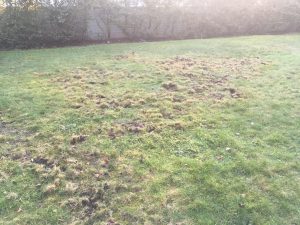I am seeing lawn damage related to European chafer beetles all over the place. Today we discovered a nasty patch of grass in Port Coquitlam. And considering the size it must have been done by raccoons, not birds. They must have enjoyed eating the grubs in early December when not much else is available. And it’s just as well. Let them eat all of the grubs.

This isn’t exactly what you want to see three weeks before Christmas. This was done by larger animals, most likely raccoons.
Shock!
It’s the residents that are in shock. Then they rush to their laptops to pen angry missives to strata management companies which, in turn, call on their landscape contractors for help.
So what can we do? Not much in December. We kicked back the messed up turf as best as we could.
Action!
In spring, you can top dress the messed up spot with a thin layer of lawn mix soil and over seed it with good quality seed. Then, follow the steps outlined in municipal handouts.
First, aerate the lawn so more water and oxygen can reach the root zone. Second, water your lawn properly; and three, cut your lawn a bit higher. Fertilizer applications are also recommended.
Nematodes
If your lawn areas aren’t excessively big, you can try applying nematodes in late summer. I recommend this to all clients who have never tried it. What can you lose? Some cash.
Order your nematodes in spring and once they arrive, store them in your fridge. The application should happen in late summer in our Tri-Cities area.
In summer, the chafers emerge from lawns and fly into tree tops to mate. Then, the females descend back to lawn areas and stick their behinds into available turf. Long, healthy grass is more of a challenge. You can always hope that they will target your neighbour’s weak lawn.
The microscopic nematodes must be watered into your wet lawns just as the grubs start growing.
I tested nematodes at one residence in 2016 and the lawn was clear on my last visit in November 2017. I will do more follow up at this client’s place because he opted out of a second application in 2017. The drawback with nematodes is that they should be applied every year. But still, I prefer one nematode application to more soil and seed installations.
Of course, there is hope for people who give up on their lawns. Alternatives exist. You just have to pick one that makes sense on your property.
As we head towards Christmas, let the animals enjoy their grub feasts and then clean up your lawns as best as you can.





